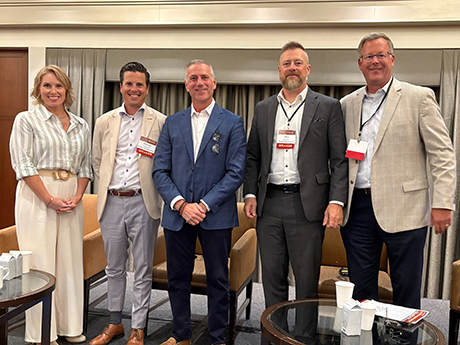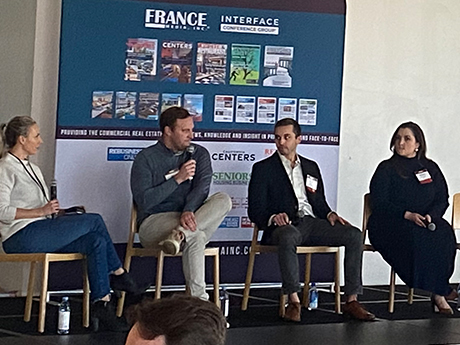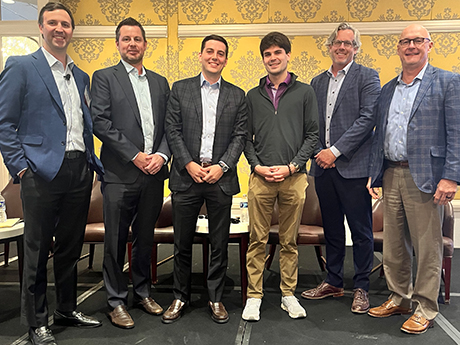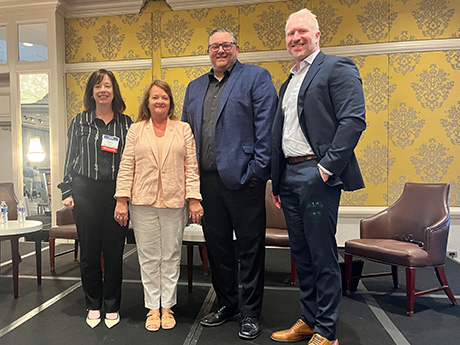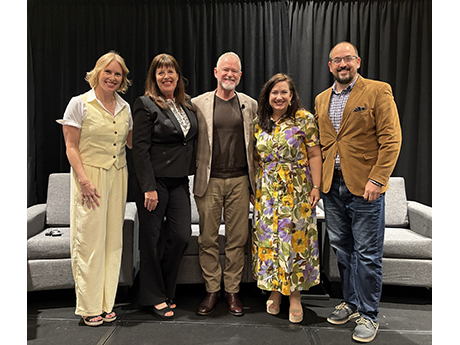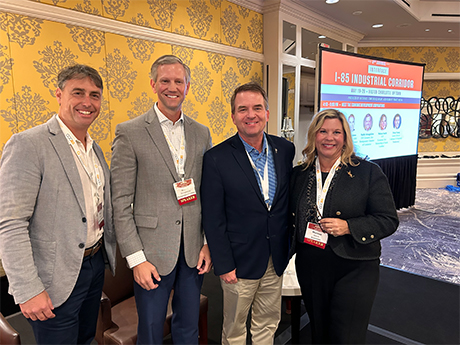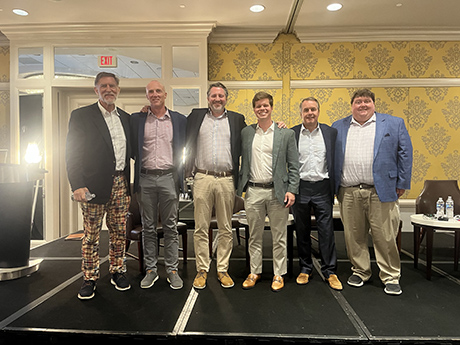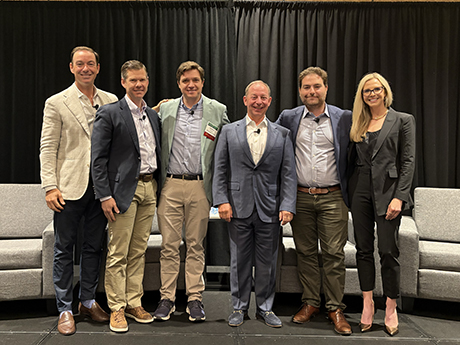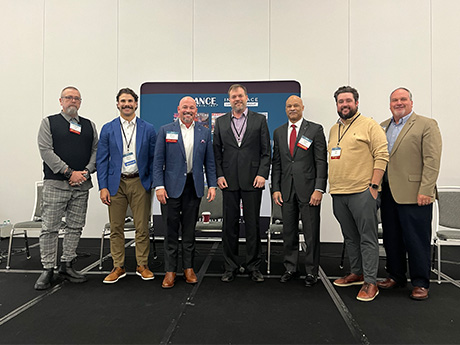CHICAGO — Philip Kroskin, head of real estate and senior vice president of investments with Sunrise Senior Living, has a message for those who are reluctant to invest in seniors housing development: “Why are you being so stupid?” Kroskin’s blunt question came during a recent two-day InterFace event at the Swissotel Chicago. Taking place June 24-25, the InterFace Seniors Housing Midwest conference drew 215 attendees and featured a number of panel sessions. Editor’s note: InterFace Conference Group, a division of France Media Inc., produces networking and educational conferences for commercial real estate executives. To sign up for email announcements about specific events, visit www.interfaceconferencegroup.com/subscribe. Joining Kroskin on stage for a panel titled “When Will Development Rebound?” during the first evening of the conference were Paul Branin, executive vice president of growth for Health Dimensions Group; Mike Mattingly, principal and co-founder of Avenue Development; Greg Markvluwer, vice president of real estate development at Erdman; and moderator Erin Berry, director of interior design Direct Supply Aptura. Development Deterrents Kroskin’s somewhat damning query was not to suggest that economic and logistical difficulties — such as heightened interest rates and labor costs — do not pose a valid deterrent. Panelists acknowledged these challenges throughout the course of session. …
Conference Coverage
AUSTIN, TEXAS — The concept of locating similar types of commercial real estate uses in close proximity to one another to allow those users to naturally develop synergies — clustering — is an age-old practice in certain asset classes like office, retail and hospitality. But the strategy can make sense for industrial real estate as well, especially in a time in which new subcategories of industrial uses are attracting capital and generating demand for space. Logistics and distribution users, for example, typically identify transportation costs as their top line item on the expense side of the ledger. Those companies have little choice but to pay top dollar for land or space near the rooftops of their existing customer bases so as to minimize transit costs. Editor’s note: InterFace Conference Group, a division of France Media Inc., produces networking and educational conferences for commercial real estate executives. To sign up for email announcements about specific events, visit www.interfaceconferencegroup.com/subscribe. Data center users cannot properly and profitably function without access to cheap electricity, hence the ability of Texas to land many of those deals via its deregulated power grid. Suppliers of smaller industrial parts and components are often supported by a handful of major manufacturers, and …
Affordable HousingConference CoverageFeaturesMultifamilyNorth CarolinaSoutheastSoutheast Feature Archive
Lenders Are Back in Action for Multifamily Development Deals, Says InterFace Panel
by John Nelson
CHARLOTTE, N.C. — In its first-quarter report, property management research firm RealPage stated that the “supply wave for multifamily was cresting” as the U.S. apartment sector set a record in terms of units absorbed (138,302), outpacing deliveries (116,092). A year prior, RealPage reported that deliveries (135,652) outstripped absorption (103,826) in first-quarter 2024. Will Block, partner and co-founder of Olympus Development Co., said that the flip in the U.S. apartment market’s supply-demand dynamic the past 12 months has made all the difference in terms of lenders’ perception. Editor’s note: InterFace Conference Group, a division of France Media Inc., produces networking and educational conferences for commercial real estate executives. To sign up for email announcements about specific events, visit www.interfaceconferencegroup.com/subscribe. “It couldn’t be more different what it looked like a year ago trying to capitalize deals in tertiary markets,” said Block. “Last year we would call 50 lenders with the hope of one to get to do it at terms that we didn’t like with ridiculous deposit requirements. I probably get four or five cold calls a week from bankers now.” Block’s comments came during the development panel at InterFace Carolinas Multifamily, an annual networking and information conference held on May 21 …
InterFace Panel: Multifamily Operators Are Utilizing Fee Transparency, Concessions to Woo Renters
by John Nelson
CHARLOTTE, N.C. — The federal government has been cracking down on price gouging in recent months. Last month, the Federal Trade Commission (FTC) implemented a rule to ban “junk fees” from live event platforms like Ticketmaster, as well as hotels and other short-term lodging. This rule precludes the vendor or property owner/management firm from being able to charge hidden fees on the back end by requiring them to put the total cost upfront, inclusive of all mandatory fees and charges. And in January, the U.S. Justice Department (DOJ), along with 10 state attorneys general, followed up on its 2023 antitrust lawsuit with RealPage by adding six of the nation’s largest property managers to the lawsuit. Editor’s note: InterFace Conference Group, a division of France Media Inc., produces networking and educational conferences for commercial real estate executives. To sign up for email announcements about specific events, visit www.interfaceconferencegroup.com/subscribe. The amended complaint alleges that the companies — Greystar; Blackstone’s LivCor LLC; Camden Property Trust; Cushman & Wakefield Inc. (formerly operating independently as Pinnacle); Willow Bridge Property Co. (formerly Lincoln Residential); and Cortland Management LLC (Cortland) — used RealPage’s pricing algorithms via the company’s YieldStar platform to share sensitive data and coordinate pricing strategies, …
By Hayden Spiess DALLAS — Although tenant demand for active adult communities remains strong, the sector is not immune to escalating construction costs, labor shortages, tariffs and general economic uncertainty, say industry professionals. Teamwork across key disciplines can help make clearing those hurdles much easier. “We’re having a hard time getting things to pencil these days,” levels Erin Berry Harps, director of interior design at Direct Supply Aptura, a senior living design and construction firm. Simultaneously, residents are as price conscious as ever, she points out. “We also have increased consumer demand for affordability,” emphasizes Harps. Editor’s note: InterFace Conference Group, a division of France Media Inc., produces networking and educational conferences for commercial real estate executives. To sign up for email announcements about specific events, visit www.interfaceconferencegroup.com/subscribe. Harps’ assessment came during the 5th annual InterFace Active Adult conference, which was held Wednesday, May 7, at The Westin Las Colinas in Dallas. Harps moderated a panel titled “Architecture, Design & Construction Trends for Active Adult Projects” at the daylong event, which attracted more than 300 industry professionals. In addition to Harps, the panel discussion included Bill Foster, a partner with Lantz-Boggio Architects; Lisa Warnock, principal and founder of Glow Interior Designs; Jarrett Cooper, vice …
InterFace: Today’s Successful Student Housing Developments Pair Great Site Selection with Efficient Design
by John Nelson
AUSTIN, TEXAS — It’s no secret that finding and entitling sites and procuring development financing has been challenging over the past few years. But Kevin Kazlow, director of capital markets with JLL, who moderated one of the development panels at this year’s InterFace Student Housing conference in Austin, Texas, believes there is lots to be excited about for the year ahead. Chief among them is the fact that the amount of capital allocated to alternative asset classes like student housing has doubled since 2018. “This group of panelists alone has a combined pipeline of about 40,000 beds under development, which is an incredibly impressive statistic and speaks to the continued demand for new student housing projects,” said Kazlow. Editor’s note: InterFace Conference Group, a division of France Media Inc., produces networking and educational conferences for commercial real estate executives. To sign up for email announcements about specific events, visit www.interfaceconferencegroup.com/subscribe. The first step in the development process is securing a great site, which Brandt Stiles, principal with Subtext, considers part of his firm’s ‘secret sauce.’ “We have a really high expectation for our team to find super high barrier to entry, hard to entitle, fortress sites and for us, it’s all about being …
Tariffs Make ‘Challenging Deals Even More Challenging’ for Economic Development Officials, Says InterFace Panel
by John Nelson
CHARLOTTE, N.C. — Tariffs are at the forefront of the U.S. economic landscape as they impact costs and timelines for a multitude of industries. For the industrial real estate sector, developers and tenants alike are monitoring the severity at which tariffs can complicate their everyday business activity, thus economic development officials are playing a crucial role in helping companies mitigate those costs and delays. “A lot of our business comes down to reducing risks for companies,” said Melissa Smith, senior vice president of the Economic Development Partnership of North Carolina. “There’s a lot of scrambling due to tariffs. They make already challenging deals even more challenging. We have to be ready to help [companies] navigate through these challenges so that they can make a successful decision.” Editor’s note: InterFace Conference Group, a division of France Media Inc., produces networking and educational conferences for commercial real estate executives. To sign up for email announcements about specific events, visit www.interfaceconferencegroup.com/subscribe. Smith’s comments came on the opening night of InterFace I-85 Industrial Corridor, a two-day networking and information event held at the Hilton Charlotte Uptown hotel on May 19-20. Brian Young, senior director of Cushman & Wakefield’s Greenville office, moderated the discussion called …
Competition for Labor, Land Is Reshaping the I-85 Industrial Corridor, According to InterFace Panelists
by Abby Cox
CHARLOTTE, N.C. — Stretching from Alabama to Atlanta, through the Carolinas and into Virginia, the I-85 corridor has long been a backbone of industrial growth in the Southeastern United States. Once celebrated as a magnet for logistic hubs, manufacturing plants and warehouse developments, this valuable category of real estate is now showing signs of strain. Editor’s note: InterFace Conference Group, a division of France Media Inc., produces networking and educational conferences for commercial real estate executives. To sign up for email announcements about specific events, visit www.interfaceconferencegroup.com/subscribe. During the COVID-19 pandemic, industrial real estate, especially warehouses and distribution centers, saw a dramatic surge in demand due to a rise in e-commerce, inventory stockpiling due to supply chain issues and lower interest rates. Fast forward five years later, the industrial market is now experiencing a slowdown due to new pressures that are reversing or slowing down many of those trends. “People are concerned about making a decision today without knowing what’s going to happen tomorrow,” said John Coleman, senior vice president of Graham &. Co. Coleman specializes in representing both tenants and landlords across the Birmingham and Montgomery industrial markets in Alabama. Coleman’s comments came while on stage during the closing panel at InterFace …
DALLAS — The evolution of active adult product is in the third inning of a nine-inning game, but some markets are clearly ahead of the curve, says Zach Crowe, managing director of U.S. real estate for private equity giant The Carlyle Group. “There are markets like Dallas, Las Vegas and Denver that have had active adult for 20 years at this point, and the product is well known. The consumer understands what it is. There are other markets with very few properties, and people have no idea what it is. It’s still incredibly early [in the game],” reports Crowe, who is based in Washington, D.C., and focuses on real estate investment opportunities in multifamily, 55+ housing and medical office properties. Editor’s note: InterFace Conference Group, a division of France Media Inc., produces networking and educational conferences for commercial real estate executives. To sign up for email announcements about specific events, visit www.interfaceconferencegroup.com/subscribe. The insights from Crowe came during the CEO panel at the fifth annual InterFace Active Adult conference. The daylong conference, which took place May 7 at The Westin Los Colinas in Dallas, attracted more than 300 industry professionals. Moderated by Ryan Maconachy, vice chairman of health and alternative assets for Newmark, the …
Affordable Housing Developers Aim to Control What They Can Control, Say InterFace Panelists
by John Nelson
ATLANTA — Interest rates. Tariffs. Natural disasters. These three factors alone frighten any developer, let alone those who are tasked with delivering our nation’s affordable housing supply. Just to get to the ribbon-cutting ceremony, developers have an uphill climb. They have to obtain the land outright or in a ground lease agreement, navigate the permitting and entitlement processes, overcome any neighborhood pushback, raise equity and borrow the necessary capital and then build these communities on time and on budget. Editor’s note: InterFace Conference Group, a division of France Media Inc., produces networking and educational conferences for commercial real estate executives. To sign up for email announcements about specific events, visit www.interfaceconferencegroup.com/subscribe. “We try to stay in control of what we’re in control of,” said Christopher Byrd, Southeast region development director of LDG Development, an affordable housing developer based in Louisville, Ky. “As long as we are in the right markets with the right growth and the right partners, we are safe and insulated.” Byrd’s comments came while on stage during the development panel at InterFace Affordable Housing Southeast, a networking and information conference held at the Cobb Galleria Centre in Atlanta on Tuesday, May 7. Kelly Williams, vice president of …


